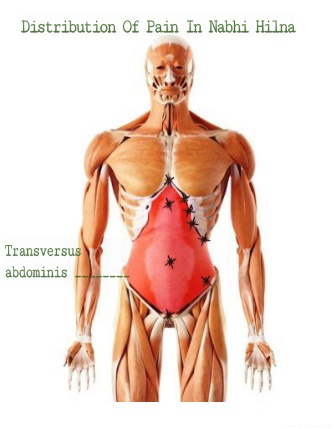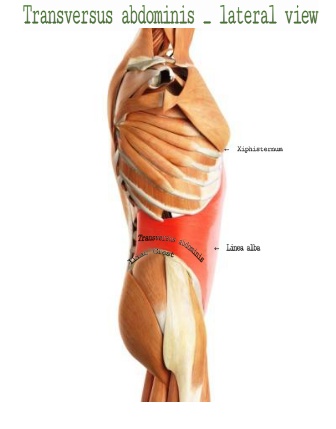Nabhi Hilna or Dharan: Scientific Analysis, Treatment Methods
Article by Vd.A.Rangaprasad Bhat.
Nabhi Hilna or Dharan is a common term used for the clinical presentation of cough, diarrhoea, vomiting, abdominal pain, flatulence, tympanitis and bloating of abdomen which occurs with a sudden onset. It is also called Nabhi Sarakhna.
The common men and folklore practitioners believe that the above presentation occurs due to displacement of the umbilicus from its median position and confirms it’s diagnosis based on the feeling of pulse over the umbilicus upon palpation.
The author of this article tries to justify the myth and facts behind this folklore diagnosis through his clinical bedside observation in establishing the condition related to a sports injury. The conventional medicine practitioners dismiss the nabhi hilna as a non-medical entity labeling it as a psychological distress, since they do not find any viable scientific cause for such conditions. Such Medically Unexplained Physical Symptoms (MUPS) usually have no consensus, as to what causes them? However, a number of theories are put forth, of which many of them share the common assumption that the MUPS, somehow is related to psychological disturbance or distress as the cause.
The prevalence of such a syndrome named Nabhi sarakhna or dharan in the Indian community seems to be mysterious as to what causes them or how causes them. A research paper is also published regarding MUPS naturel of the syndrome, here.
Table of Contents
Synonyms
Dharan or Nabhi Sarakna / Nabhi hatna / Gola khisakna / pichoti khisakhna / Nabhi chadna / Dharan jana / Nabhi palatna / Nabhi hilna.
Pre-disposing factors
The following factors were found to be predisposing causes noted during history taking from the health seekers. Landing with one leg straight and other leg bent at knee while jumping over the floor from height.
Bending and leaning over sideways while sitting in a chair to pick an article fallen over the ground.
Walking or trekking over uneven surface of land.
Climbing the staircase hurriedly, skipping a step and taking two steps each at a time.
Sitting over the raised edge of the car seat near the window and slightly swaying the body with the flexed elbow placed over the window.
Getting inflicted with a hard punch over the sides of the rib or the abdomen.
Repeatedly kick starting of the scooter by sitting over the seat, due to some mechanical snag.
Unexpected and violent repetitive sneezing while sitting in a chair
Some medical interventions like Trans vaginal sonography, where in the subject is to maintain the lithotomy posture until the investigation gets over.

Clinical analysis
Clinical Analysis of Nabhi Dharan:-
The Nabhi dharan presents with collective symptoms like kasa (cough) ,atisara (diarrhoea), Chardi (vomitting), adhmana (bloating,) atopa (tympanitis), severe abdominal muscle cramp (shula), hrcchUla (chest pain), parshva shula (pain over sides of ribs and flanks) and Pulsatile sensation beneath the umbilicus.
With the help of position of nipples in males and toes in females in comparison to location of umbilicus over the median plane, the partial shifting of the umbilicus or Nabhi Hilna gets confirmed through inspection. Followed by inspection, the physician with the help of palpation feels the presence of pulsation underneath the displaced umbilicus, to confirm the diagnosis of this cultural syndrome.
Since, the patients experience a bizarre phenomenon of gabrahat (discomfort) in the abdomen with pulsatile feeling underneath the nabhi in association with spontaneous diarrhoea and or vomiting not getting controlled by any means, the chief presenting complaint by the health seekers always gets emphasized giving importance to nabhi region. Hence the colloquial name of the syndrome has got famous with the mention of nabhi as the prefix.
The displacement of the umbilicus and the resultant pulsations underneath the umbilicus as observed in such subjects became the reason for the suffix hilna or sarakna or pisakhna or hatna etc.
In fact, this event of the slight disposition of the umbilicus deviating from its normal position is not the cause for the syndrome of symptoms but the one among the effect of the cause of the muscle sprain occurring in the core muscle of the abdomen, named the Transversus abdominis muscle.
The aforesaid muscle and its connection with the umbilicus; the clinical reasoning behind the symptoms getting exhibited like that of a syndrome etcetera such factors will get enlightened when we try to have the clear anatomical location of the muscle with specific reference to its origin and insertion point in the human physique.
Anatomy of Transversus abdominis
The muscle originates from Iliac crest, inguinal ligament, thoracolumbar fascia, and costal cartilages 7-12 and inserts over Xiphoid process, linea alba, pubic crest and pecten pubis via conjoint tendon and thus the muscle ends middle of the abdomen. The aponeurosis of the muscle passes horizontally to reach the midline where in it gets blended and inserted into the linea alba. The upper three fourth of it gets blended with the internal oblique by lying behind the rectus muscle. Whereas the lower fourth gets settled in front of the rectus abdominis.

Functions of Transversus abdominis
The abdominal muscles in general support helps to compress the ribs and viscera to provide thoracic and pelvic stability. It also helps in maintaining the intra abdominal pressure.
The deep abdominal muscle like T.A along with the muscles of the back forms the core muscles. It is these core muscles, which help maintain our body stable maintain the balance and protect the spine.
The muscle prevents the viscera from protruding outward the abdomen by holding the structures within inside, hence the common name “Corset muscle”.
The core muscles resist a specific force, be it static of dynamic one. Thus, they take up the cohesive force occurring over the bones and direct autonomic force through various joints, in the desired direction.
They resist against the gravitational force in maintaining the body balance, as could be seen while walking down a slope hill.
They control the coronal (side to side) and sagittal (forward and behind) planes of body movement.
They quickly adapt to the changes in speed by means of a quicker contraction; the motion by means of a quicker reaction time of contraction and the tone or power by means of the amount of resistance exhibited over a particular period.
Clinical hypothesis
Clinical hypothesis about inter relation between Nabhi dharan and TA muscle:
Having explained about the structure and functions of the TA muscle let travel into the details of how it may be involved in the nabhi dharan syndrome with the following clinical hypothesis.
Due to the pre mentioned causes, when a person gets involved in adventurous activities like jumping, trekking, skiing etc and other such activities, which require proper balancing of the trunk and spine, and assume the person loses his balancing of the core muscles inclusive of TA muscle. The excessive force used to get hold of balance, from sudden stopping of the velocity of the activity involved along with gravitation force intervening, the TA muscle gets over stretched and stressed either at their origin or insertion points.
Like wise, in case of sudden and violent lateral rotation of the body, while doing activities like skiing or skating as evitable it becomes during a sharp curved turning, the conjunction point between the RA and TA muscle or over the area of the floating ribs or over the para spinal muscles the stress gets exerted.
As a result of these events the subjects exhibits sore to sharp pain in the areas of origin and insertion of TA muscle viz (in no particular order) – over the ribs, the ensuing intercostals, the vertebra, pubic symphysis, the iliac crest and the conjoint tendons, linea alba, xiphisternum, mid of the flank etc.
This makes the inhalation of the breathing process much painful due to the bucket handle expansion of the rib cage occurring during the process. As the ribs expand, the muscle fibres attached to it are stretched over the stressed points exhibiting pain.
Like wise over the pubic symphysis, the iliac crest and the vertebra too, the pain gets felt when the abdomen expands.
Pain in the area of xiphisternum causes exertion and increases the diaphragmatic movement resulting in oppressed feeling in the throat due to diaphragmatic irritation, thereby exhibiting the cough clinically.
The increase in the intra abdominal pressure occurring post to the event of insult to the TA muscle and the ensuing diaphragmatic irritation causes the reflex of gagging resulting in nauseating feeling or further to vomiting. Furthermore, the increase in peristaltic waves results in diarrhea, tympanitis, bloating and mild colic.
The sudden and unexplained above such events causes anxiety to the subject causing palpitation and the resulting increased cardiac output exerts pressure over the major aortic vessel, been felt as the pulsation in the abdominal aorta.
And since the abdominal aorta ends and bifurcates at the level of the umbilicus underneath and slightly little to the left of the nabhi, the subject starts feeling a sense of gabrahat or unexplained pulsation over the navel area.
When the muscle gets sprained, the trigger point pulls the muscle fibers towards the sprained area forcibly. At this instance the linea alba, over which the umbilicus is attached, too gets deviated to the side of muscle pull giving an appearance as if the umbilicus is displaced from its original median position towards the side.
The author in his clinical practice of marma chikitsa have found such above common pattern of clinical presentation in cases of Nabhi sarakhna pointing towards a sports medical condition related to the core muscle of the abdomen, the transverses abdominis sprain.
Ayurvedic management
Ayurveda Perspective of Management:
As per Ayurveda, following symptoms are found –
Kati graha – stiffening of hip region
Parshva – stiffening of flanks
Urograha – stiffening of chest region
Atisara – diarrhea
Suitable medicines choices:
Deepaneeya, Pachaneeya – digestive and carminative medicines are used, such as
Hingwashtaka churna
Lavana Bhaskara Churna
Hinguvachadi churna
Ajamodadi Churna
Jeerakadyarishta
Vata Anulomana medicines are used, such as
Indukanta ghrita, Indukanta Kashaya,
Sukumara ghrita, Sukumara Kashaya
Kastooryadi Gulika
Gangadhara Churna
To relieve stiffness of abdominal muscles,
anti inflammatory medicines such as
Yogaraja guggulu,
Rasnadi guggulu
Ashwagandharishta,
Balarishta,
Ksheerabala taila are used.
For external application, gentle oil massage is done with oils like –
Mahanarayana taila
Narayana taila
Dhanwataram tailam
Kottamchukkadi tailam
Vishagarbha taila.
This is followed by medicines for symptomatic relief for vomiting, diarrhea and cough are administered.
The author follows a NCMT procedure (non-conventional marma taping procedure) devised by him where in tapes are applied over certain marma points in specific pattern, to provide relief from the pain and other symptoms.
The advantage of the method is, it helps the patient to carry over his daily activities without the discomfort of pain.
General precautions and advice
Take rest during the illness.
Sleep, facing roof, with folded legs. This relaxes the abdominal muscles better.
Drinking a cup of buttermilk, mixed with a teaspoon of fengureek powder and a pinch of asafoetida (heeng) is useful.
Drink lukewarm or hot water, in place of normal water till the illness is completely relieved.
Vd.A.Rangaprasad Bhat,
Chief Physician,
PADMANILAYAM, 49/46, K.M.N St,
Mandavelipakkam, Chennai-600028
Email: [email protected]









